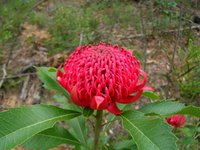 The birds are singing in my garden. What a lovely way to wake up, in the freshly washed and scrubbed village of Robertson (after a week of rain).
The birds are singing in my garden. What a lovely way to wake up, in the freshly washed and scrubbed village of Robertson (after a week of rain).The main "culprits" are the Golden Whistlers (Pachycephala pectoralis) and the skulking Eastern Whipbirds (Psophodes olivaceus). I love the sounds they make, and the fact that they feel happy to make them just outside my window.
The view is a recent afternoon vista, with misty clouds arising from near Belmore Falls, after a series of Spring showers.
Today I would ask you to be just a little adventurous, and come on a journey with me, that will provide a feast for your eyes, and ears, and let you know just a little of what I hear each morning, as I wake.
There is a wonderful website for the Lamington National Park, in south-east Queensland. That is a rainforest area, and it has many of the same birds and plants as are found in Robertson and on the Illawarra Escarpment. Not only does this site have 1700 images, it also has "sound files". The main menu page gives you the choice to view plants, birds, frogs, fungi and mammals. Wonderful for someone who is interested in rainforests.
Bird and Frog calls may be heard by clicking on the "ear" symbol on any particular page (only for Birds and Frogs). Your computer will then download the .wav file, which you then click on, opening it with your computer's "sound" program. Then just click the play button (>). This downloading process may be a little slow, and involved, but it is worth it.
If you wish to hear the bird calls which I woke up to, this morning, click on the following links, for the Golden Whistler and then the Eastern Whipbirds.
Incidentally, I say Whipbirds, plural, as their call is a duet. The male makes the long drawn-out shrill whistle, then the "crack" sound, and the female answers with the "chew, chew" call. If you listen carefully, you will hear that it is more distant from the recorder. In Robertson, the female Whipbirds give their answering call in triplicate "chew, chew, chew".
If you are inclined to browse, here is the main menu link. I shall try and make this a permanent link from my Blog, as soon as I remember how to do that!
Congratulations to the Management of the Lamington National Park, and the University of Queensland School of Natural and Rural Systems Management for a wonderful website.





